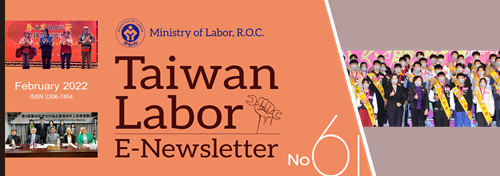NO.61
- Last updated:2022-02-24
- Clicks on the following title, but browses this article fast
- Policies & Regulations Legislative Yuan Passes Amendments to "Act of Gender Equality in Employment" to Create a Friendlier Childcare Environment OSHA, MOL Announces "Guidelines on Occupational Safety and Health for Night Work" for Company Execution and to Protect the Safety and Health of Night Workers Amendments to the Table of Grades of Labor Insurance Salary and Monthly Contribution Classification of Labor Pension Effective January 1, 2022
- News Outlook 51st National Skills Competition: President Hopes Skills Can Enrich Lives of Young Competitors at Gold, Silver, and Bronze Medalist Award Ceremony "Good Climate & Environment Keeping Us Safe, Full Prosperity in All Our Agricultural Laboring" ─ MOL Develops New Agricultural Assistive Device, Jointly Creates an Agricultural Workplace Utopia 8th ANZTEC Trade and Labour Committee Meeting Focuses on "the Changing Nature of Work and Employment" and "Protecting Human Rights for Foreign Workers"
Legislative Yuan Passes Amendments to "Act of Gender Equality in Employment" to Create a Friendlier Childcare Environment

Amendments to the Act of Gender Equality in Employment came into effect on January 18, 2022, as designated by the Executive Yuan. The amendments create a friendlier childcare environment by improving various benefits for employees during the childbirth and childrearing periods. The key points of the current amendments are as follows:
| I. | To accommodate the increase of preventative pregnancy health checkups to 14 checkups, pregnancy checkup leave has been increased from 5 days to 7 days. To encourage employees to accompany their spouses during pregnancy checkups, "paternity leave" has been amended to "pregnancy checkup accompaniment and paternity leave," and the original 5 days leave has been extended to 7 days to promote responsible parenting. Additionally, to avoid increasing the burden on employers, after employers have paid wages for "pregnancy checkup leave" and "pregnancy checkup accompaniment and paternity leave," they may apply to the central government's competent authorities for compensation of the portions exceeding 5 days. However, this compensation will not apply to companies for whom other legal provisions stipulate payment of wages for "pregnancy checkup leave" and "pregnancy checkup accompaniment and paternity leave" in excess of 5 days. |
| II. | A provision has been added allowing employees hired by employers with fewer than 30 employees to also request reductions or adjustments of working hours after negotiating and reaching a suitable arrangement with the employer. |
| III. | Article 22 has been deleted. Regardless of whether the spouse is currently employed, and with no further requirement of a proper reason, both parents may freely choose whether to simultaneously apply for unpaid parental leave for raising children or family care leave after considering their overall financial situation and division of domestic labor. |
As the Ministry of Labor (MOL) has pointed out, the Act of Gender Equality in Employment has been in effect for almost 20 years. The current amendments can give further support to childrearing parents, with "pregnancy checkup leave" and "pregnancy checkup accompaniment and paternity leave" being extended from 5 days to 7 days once the amended articles come into effect. Salary payments for the additional 2 days will be entirely subsidized by the central government. Additionally, to encourage parents to both be present as their children grow up, they will now be allowed to simultaneously apply for unpaid parental leave for raising children, and with the recent amendment to the Employment Insurance Act, both parents can receive financial aid at the same time. Furthermore, with the relaxation of flexible working hour negotiations, business units can also be guided to allow employees even more flexibility.
Keywords: Act of Gender Equality in Employment, Pregnancy Checkup Leave, Unpaid Parental Leave for Raising Children
OSHA, MOL Announces "Guidelines on Occupational Safety and Health for Night Work" for Company Execution and to Protect the Safety and Health of Night Workers

To strengthen the occupational safety and health of night work, ensure the mental and physical health of night workers, and reduce the risks of workplace violence, the Occupational Safety and Health Administration (OSHA), Ministry of Labor (MOL) stipulated the "Guidelines on Occupational Safety and Health for Night Work" on Nov. 30, 2021. The guidelines provide the means for industry establishments to identify possible night work hazards and carry out risk assessment in accordance with their actual needs and industry characteristics, as well as the appropriate control and prevention measures that should be adopted when reasonable and feasible to do so.
OSHA stated that night work hazards can vary based on the industry, location, and nature of work. While taking into account factors such as occupational safety and health facilities, related prevention measures must also assess the personal safety and health of workers. To ensure the safety and health of night workers, the guidelines bring together practical standards and related regulations from the current Occupational Safety and Health Act, asking employers to conduct assessments of risk factors such as work environment, occupational safety and health facilities, personal safety, and physical and mental health. Prevention facilities and management measures must be adopted in response to the results of these assessments. The guidelines also delineate important inspection items for industry establishments, such as work environment, safety and health facilities, personal safety protection, physical and mental health management, emergency response mechanisms, and employee education and training. This allows implementation of effective risk management systems and ensures safety and health at work environments.
The nature of night work is diverse, and workplace risk factors can vary based on the characteristics of each industry. OSHA reminds industry establishments that the safety of employees should take priority over any other matter, industry establishments should carry out risk assessment for each workplace, review and examine emergency response procedures, allocate adequate manpower, implement related employee education and training, and uphold labor rights and provide the necessary compensation and assistance for employees who have suffered occupational injuries. These reminders were made clearly known to all parties. Labor inspection agencies will continue conducting promotion, oversight, and inspection work to protect the safety and health of workers.
Keywords: Occupational Safety and Health for Night Work, Hazards and Risks, Personal Safety Protection
Amendments to the Table of Grades of Labor Insurance Salary and Monthly Contribution Classification of Labor Pension Effective January 1, 2022
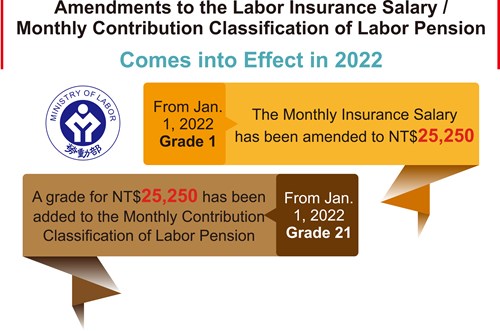
In response to the adjustment of the basic wage in 2022 from NT$24,000 to NT$25,250 per month, the "Table of Grades of Labor Insurance Salary" and "Monthly Contribution Classification of Labor Pension" were amended accordingly, coming into effect on January 1, 2022. Labor insurance salary was adjusted for 3,368,322 people, while labor pension contribution wage was adjusted for 1,417,717 people. Insured units and contributing units do not need to file separately.
The newly amended Table of Grades of Labor Insurance Salary updates Grade 1 to NT$25,250. The original Grade 1 (NT$24,000) has been moved to the part-time worker grade, the original Grade 2 (NT$25,200) has been removed, the original Grade 3 (NT$26,400) has been moved to Grade 2, while the remaining grades have been shifted in order. There are a total of 14 grades after the amendment. As for the Monthly Contribution Classification of Labor Pension, a new grade (NT$25,250) has been added, while the original grade (NT$25,200) has been removed. The remaining grades have not been changed.
To simplify the administrative procedures by insured units, the Bureau of Labor Insurance (BLI) has adjusted insured persons' and workers' insurance salary and contribution wage between NT$24,000 and NT$25,200. As of January 1, 2022, the insurance salary and contribution wage of such persons have been automatically updated to NT$25,250. Furthermore, adjustments shall not be made for those with insurance salary and contribution wage of NT$24,000 (the basic wage grade) and who are recorded as being part-time workers, low-income members of occupational unions, people with disabilities under sheltered employment, or those trainees of vocational training institutions, as their actual income do not reflect adjustments to the basic wage. The insurance salary and contribution wage of such persons shall remain at NT$24,000.
To facilitate the insurance premium deductions and labor pension collections for insured units and contributing units, the "Table of Grades of Labor Insurance Salary," "Table of Shared Insurance Premiums," and "Monthly Contribution Classification of Labor Pension" effective in 2022 have been placed in the "Frequently Used Services" -> "Table Download" section of the BLI website. We encourage the public to download and use them!
Keywords: Table of Grades of Labor Insurance Salary, Monthly Contribution Classification of Labor Pension, Basic Wage Adjustment
51st National Skills Competition: President Hopes Skills Can Enrich Lives of Young Competitors at Gold, Silver, and Bronze Medalist Award Ceremony
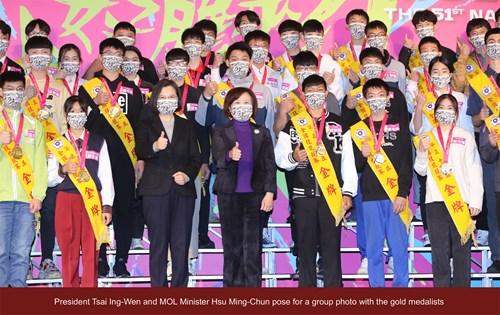
The 51st National Skills Competition was held from September 29 to December 4, 2021, spanning over two months of events and producing medal winners across 57 youth skills and 12 junior skills.
The Gold, Silver, and Bronze Medalist Award Ceremony was held on December 27, 2021 at the Regent Taipei. President Tsai Ing-Wen and Ministry of Labor (MOL) Minister Hsu Ming-Chun attended in person to congratulate and encourage the gold, silver, and bronze medalists.
As President Tsai expressed in her remarks, the MOL employed a number of methods to overcome the effects of the pandemic at this year's competition, using crowd control and site separation strategies to accomplish the difficult task of completing all the events in the competition. Many competitors also sacrificed their rest and recreation time to diligently train and improve their skills. This level of motivation is the force driving Taiwan to continuously advance in various fields, and further demonstrates that technical and vocational education is no longer just about skills and training. President Tsai encouraged competitors to use their skills to help society, solve problems, and carry Taiwan further towards progress and development.
As MOL Minister Hsu Ming-Chun expressed, competitors placed in the top three for their skills in this year's competition stood out among 963 candidates, demonstrating the fruits of their daily practice and winning excellent results in the competition. She hopes that competitors can keep pushing themselves, using their skills to contribute to society and become the force behind the nation's progress and development.
The MOL further stated that since 1968 it has been holding the National Skills Competitions every year to help showcase young people's abilities to society and demonstrate the results of their training. The Competition provides a professional stage for talents in various skills to compete together, and to select exceptionally skilled young competitors to represent the nation in the WorldSkills Competitions. Due to the effects of COVID-19 this year, venue separation and crowd control across skills competitions were adopted to ensure the health and safety of Competitors and related personnel, and to comply with the epidemic prevention guidelines of the Central Epidemic Command Center. The competition concluded smoothly and was a complete success.
Keywords: 51st National Skills Competition, Gold, Silver, and Bronze Medalist Award Ceremony, President Tsai Ing-Wen
"Good Climate & Environment Keeping Us Safe, Full Prosperity in All Our Agricultural Laboring" ─ MOL Develops New Agricultural Assistive Device, Jointly Creates an Agricultural Workplace Utopia
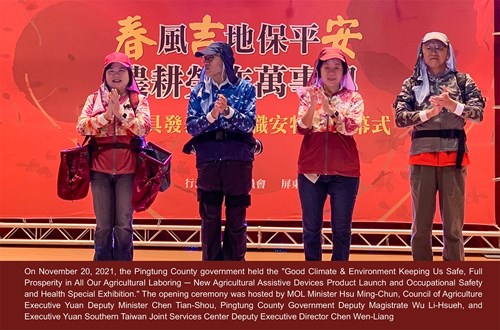
One in every 20 people in Taiwan works in agriculture, while 63.3% of this agricultural population is over 50 years of age. This reflects the serious state of Taiwan's aging agricultural workforce.
Agricultural populations are subject to a variety of occupational hazards, including long-term high heat exposure and heatstroke, sprayed pesticides, snake and insect bites, lifting and moving heavy objects, cut injuries from vegetation, and muscular and skeletal injuries to the joints and lumbar region.
To safeguard against agricultural work hazards in Taiwan, the Institute of Labor, Occupational Safety and Health, Ministry of Labor (MOL) utilized occupational health technology to design two occupational assistive devices for middle-aged and elderly agricultural workers: the "Agricultural Crop Harvesting Bag and Harness Set" and "Agricultural Sun Protection Protective Clothing and Sun Hat Set." Main design features include:
I. Breathable, sun protective material.
II. Harvesting pocket distributes loads over the entire body.
III. Pressure reducing outfit and accessories reduce work hazards.
IV. Assistive device alleviates load on the back.
These new items were presented on November 20, 2021, at the "Good Climate & Environment Keeping Us Safe, Full Prosperity in All Our Agricultural Laboring ─ New Agricultural Assistive Devices Product Launch and Occupational Safety and Health Special Exhibition," held by the Pingtung County government. An on-site demonstration, in which participants personally donned the outfits, was given by MOL Minister Hsu Ming-Chun, Pingtung County Government Deputy Magistrate Wu Li-Hsueh, Council of Agriculture Executive Yuan Deputy Minister Chen Tian-Shou, and Executive Yuan Southern Taiwan Joint Services Center Deputy Executive Director Chen Wen-Liang. This event highlighted the ability of the central authorities to consolidate resources across departments and cooperate with local governments. The research results are tangible proof of success from working together to implement and create an agricultural workplace utopia.
Keywords: Agricultural Assistive Devices, Agricultural Crop Harvesting Bag and Harness Set, Agricultural Sun Protection Protective Clothing and Sun Hat Set
8th ANZTEC Trade and Labour Committee Meeting Focuses on "the Changing Nature of Work and Employment" and "Protecting Human Rights for Foreign Workers"
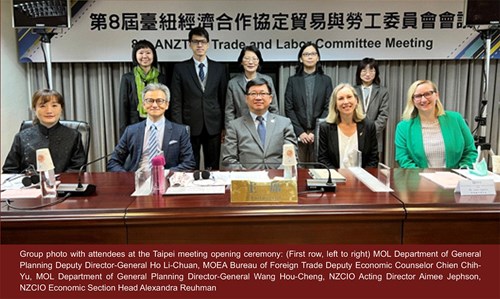
The 8th session of the Agreement between New Zealand and the Separate Customs Territory of Taiwan, Penghu, Kinmen, and Matsu on Economic Cooperation (ANZTEC) Trade and Labour Committee Meeting was held via videoconferencing in the morning of November 24, 2021 (Taipei time). This year, the conference was hosted by New Zealand and the opening ceremony was personally attended in both locations by foreign representatives of Taiwan and New Zealand ─ Ambassador Bill Chen Keh-Ming of the Taipei Economic and Cultural Office in New Zealand and Acting Director Aimee Jephson of the New Zealand Commerce and Industry Office (NZCIO). The conference began with a discussion of the "Labor Situation Update" in both countries. Focusing on the issue of "the Changing Nature of Work and Employment," a thorough discussion was held regarding New Zealand's promotion of a three-way dialog mechanism in the development of social unemployment insurance and unemployed worker payment solutions. Taiwan also shared important points from its new special legislation, the "Labor Occupational Accident Insurance and Protection Act." Further exchanges were had regarding measures to ensure the human rights of foreign workers and to learn from the policy experience of one another with respect to protecting human rights for foreign workers. Finally, the execution of ANZTEC and labor guideline issues were jointly reviewed, with the hope that future exchange and cooperation on labor issues can continue to deepen within the framework of ANZTEC and APEC.
Keywords: ANZTEC, the Changing Nature of Work and Employment, Foreign Worker Human Rights
- Source:Department of General Planning
- Publication Date:2022-02-23
- Count Views:
File
- Taiwan Labor E Newsletter No61 pdf

